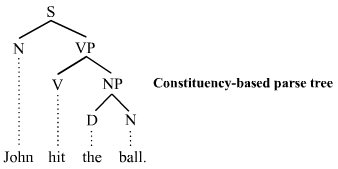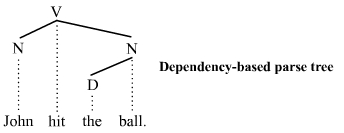Using the Grammar Above Again Draw Parse Trees for Each of the Following a X Xa1

A parse tree or parsing tree [ane] or derivation tree or concrete syntax tree is an ordered, rooted tree that represents the syntactic structure of a string co-ordinate to some context-complimentary grammer. The term parse tree itself is used primarily in computational linguistics; in theoretical syntax, the term syntax tree is more than common.
Concrete syntax trees reverberate the syntax of the input language, making them distinct from the abstruse syntax trees used in computer programming. Unlike Reed-Kellogg judgement diagrams used for education grammer, parse copse do not employ distinct symbol shapes for different types of constituents.
Parse trees are commonly constructed based on either the constituency relation of constituency grammars (phrase construction grammars) or the dependency relation of dependency grammars. Parse trees may exist generated for sentences in natural languages (see natural language processing), as well every bit during processing of computer languages, such equally programming languages.
A related concept is that of phrase marker or P-mark, as used in transformational generative grammar. A phrase marker is a linguistic expression marked every bit to its phrase construction. This may be presented in the class of a tree, or as a bracketed expression. Phrase markers are generated by applying phrase structure rules, and themselves are subject to further transformational rules.[2] A gear up of possible parse trees for a syntactically cryptic judgement is called a "parse forest."[three]
Nomenclature [edit]

A parse tree is made upward of nodes and branches.[4] In the picture the parse tree is the entire construction, starting from South and ending in each of the foliage nodes (John, brawl, the, hit). In a parse tree, each node is either a root node, a branch node, or a foliage node. In the higher up instance, S is a root node, NP and VP are branch nodes, while John, ball, the, and hit are all leaf nodes.
Nodes can also be referred to every bit parent nodes and child nodes. A parent node is i which has at least one other node linked by a branch under it. In the instance, S is a parent of both NP and VP. A kid node is one which has at least ane node straight above it to which it is linked by a co-operative of the tree. Once more from our example, striking is a child node of Five.
A nonterminal function is a function (node) which is either a root or a branch in that tree whereas a terminal office is a role (node) in a parse tree which is a foliage.
Constituency-based parse trees [edit]
The constituency-based parse trees of constituency grammars (phrase structure grammars) distinguish between terminal and non-concluding nodes. The interior nodes are labeled by non-concluding categories of the grammar, while the leaf nodes are labeled by terminal categories. The image below represents a constituency-based parse tree; it shows the syntactic structure of the English sentence John hitting the brawl:
The parse tree is the entire construction, starting from S and ending in each of the leaf nodes (John, hit, the, brawl). The post-obit abbreviations are used in the tree:
-
-
- S for judgement, the top-level structure in this example
-
-
-
- NP for noun phrase. The first (leftmost) NP, a single noun "John", serves as the subject of the judgement. The second one is the object of the judgement.
-
-
-
- VP for verb phrase, which serves as the predicate
-
-
-
- V for verb. In this case, information technology'due south a transitive verb hit.
-
-
-
- D for determiner, in this instance the definite article "the"
-
-
-
- Due north for noun
-
Each node in the tree is either a root node, a branch node, or a leafage node.[v] A root node is a node that doesn't take any branches on top of it. Within a sentence, at that place is only e'er one root node. A branch node is a parent node that connects to two or more kid nodes. A leaf node, nevertheless, is a terminal node that does non dominate other nodes in the tree. S is the root node, NP and VP are branch nodes, and John (N), hit (V), the (D), and ball (N) are all foliage nodes. The leaves are the lexical tokens of the sentence.[6] [ page needed ] A parent node is ane that has at least one other node linked by a branch nether information technology. In the example, Southward is a parent of both N and VP. A child node is 1 that has at to the lowest degree ane node directly above information technology to which it is linked by a co-operative of a tree. From the example, hit is a child node of V. The terms mother and girl are also sometimes used for this relationship.
Dependency-based parse copse [edit]
The dependency-based parse trees of dependency grammars[7] come across all nodes every bit last, which means they practice not acknowledge the distinction between terminal and non-terminal categories. They are simpler on average than constituency-based parse copse because they comprise fewer nodes. The dependency-based parse tree for the case judgement above is every bit follows:
This parse tree lacks the phrasal categories (S, VP, and NP) seen in the constituency-based counterpart to a higher place. Like the constituency-based tree, constituent structure is acknowledged. Any consummate sub-tree of the tree is a elective. Thus this dependency-based parse tree acknowledges the subject noun John and the object substantive phrase the ball equally constituents just like the constituency-based parse tree does.
The constituency vs. dependency distinction is far-reaching. Whether the boosted syntactic structure associated with constituency-based parse trees is necessary or beneficial is a thing of debate.
Phrase markers [edit]
Phrase markers, or P-markers, were introduced in early on transformational generative grammer, as developed past Noam Chomsky and others. A phrase marker representing the deep structure of a sentence is generated past applying phrase construction rules. Then, this application may undergo further transformations.
Phrase markers may exist presented in the course of trees (equally in the in a higher place section on constituency-based parse trees), but are often given instead in the form of "bracketed expressions", which occupy less space in the retentiveness. For example, a bracketed expression corresponding to the constituency-based tree given above may be something like :
As with trees, the precise structure of such expressions and the amount of detail shown can depend on the theory being practical and on the points that the query author wishes to illustrate.
See likewise [edit]
- Abstract syntax tree
- Constituent (linguistics)
- Dependency grammar
- Computational linguistics
- Parsing (syntax analysis)
- Phrase structure grammar
- Judgement diagram
- Terminal and nonterminal symbols
Notes [edit]
- ^ See Chiswell and Hodges 2007: 34.
- ^ Noam Chomsky (26 December 2014). Aspects of the Theory of Syntax. MIT Printing. ISBN978-0-262-52740-8.
- ^ Billot, Sylvie, and Bernard Lang. "The construction of shared forests in cryptic parsing."
- ^ "The parsetree Parcel for Drawing Trees in LaTeX". www1.essex.ac.uk.
- ^ See Carnie (2013:118ff.) for an introduction to the basic concepts of syntax copse (e.g. root node, concluding node, non-terminal node, etc.).
- ^ Meet Aho et al. 1986.
- ^ See for example Ágel et al. 2003/2006.
References [edit]
- Ágel, 5., Ludwig Eichinger, Hans-Werner Eroms, Peter Hellwig, Hans Heringer, and Hennig Lobin (eds.) 2003/six. Dependency and valency: An international handbook of contemporary research. Berlin: Walter de Gruyter.
- Carnie, A. 2013. Syntax: A generative introduction, third edition. Malden, MA: Wiley-Blackwell.
- Chiswell, Ian and Wilfrid Hodges 2007. Mathematical logic. Oxford: Oxford Academy Press.
- Aho, A. V., Sethi, R., and Ullman, J. D. 1986. Compilers: Principles, techniques, & tools. Reading, MA: Addison-Wesley.
External links [edit]
- Syntax Tree Editor
- Linguistic Tree Constructor
- phpSyntaxTree – Online parse tree drawing site
- phpSyntaxTree (Unicode) – Online parse tree drawing site (improved version that supports Unicode)
- rSyntaxTree Enhanced version of phpSyntaxTree in Scarlet with Unicode and Vectorized graphics
- Qtree – LaTeX package for drawing parse copse
- TreeForm Syntax Tree Drawing Software
- Visual Introduction to Parse Trees Introduction and Transformation
- OpenCourseOnline Dependency Parse Introduction (Christoper Manning)
- Penn Treebank 2 Constituent Tags
matthewsoblactiones.blogspot.com
Source: https://en.wikipedia.org/wiki/Parse_tree


![{\displaystyle [_{S}\ [_{\mathit {N}}\ {\text{John}}]\ [_{\mathit {VP}}\ [_{V}\ {\text{hit}}]\ [_{\mathit {NP}}\ [_{\mathit {D}}\ {\text{the}}]\ [_{N}\ {\text{ball}}]]]]}](https://wikimedia.org/api/rest_v1/media/math/render/svg/995d5d3a584be537cf98b07b8f03f44656fd826c)
0 Response to "Using the Grammar Above Again Draw Parse Trees for Each of the Following a X Xa1"
Post a Comment